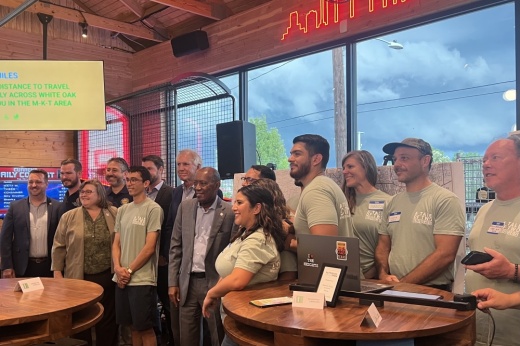The organization that set up the meeting, dubbed A Tale of Two Bridges, was started by Heights resident Emmanuel Nunez in February. The project calls for building two new bridges over White Oak Bayou to give pedestrians and cyclists easier access between the MKT Trail in the Heights and the White Oak Bayou Trail, which runs through the Heights while also connecting to communities south of I-10.
Right now, there is a 1.3-mile gap between existing bridges over White Oak Bayou in the area—the Cottage Grove Bridge and the bridges at Heights Boulevard and Yale Street—according to project website. The project would also beautify more than 30 acres of green space in the Heights and protect habitats.
In an interview with Community Impact Newspaper, Nunez said he was inspired to push to fast-track the project, which was already in Houston's long-term bike plan, after seeing how projects in Austin were able to transform urban parts of the city.
When he first began the effort, Nunez said city officials told him there were no concrete plans to move the project forward, but that if the community showed a want for it, officials would look into making it happen.
From there, Nunez said he launched an Instagram page, where he shared informational pictures. People were immediately excited, he said, calling the project something that is “missing from the community.”
“It's been about 10 years that I've been following urban transformation projects like this,” Nunez said. “Everywhere I look now I think of what this could be. So this happened to be one that seemed like it was really low-hanging fruit because it's so easy to do, yet it’s so transformative.”
The two bridges would also provide a multimodal connection; improved access to transit stops and mobility routes; and safer access to schools, businesses and churches along the Washington Corridor for pedestrians and bicyclists, Nunez said. According to the website, the project will complement other ongoing projects in the area, such as the Patterson Street Bikeway, Shepherd and Durham’s reconstruction and the METRO Rapid project.
ATOTB garnered support from city officials, including Mayor Sylvester Turner, who spoke at the Aug. 10 event. Turner said the project is about designing and building a city for the future that is focused on multimodal forms of transportation. He said the project would also help mitigate climate change.
“It’s about building a resilient city,” Turner said. “Push us to do more. Encourage us, push us, be a little disruptive ... from that, good things will happen in our city.”
In an interview with Community Impact Newspaper, Houston’s Chief Transportation Planner David Fields said the project is in its infancy, but the city is happy to work on the design and with local coordination and community engagement. It would also require coordination with the Texas Department of Transportation.
“The city is a big supporter of all connectivity, especially the 1,800 miles in the bike plan,” Fields said.
Joe Cutrufo, executive director of BikeHouston—one of the organizations helping bring ATOTB’s vision to fruition—said connectivity in Houston is important. Right now, those who travel on bike do not have many direct routes, Cutrufo said. Instead they are forced to take a roundabout way to find streets that are safe and connected to trails.
“[BikeHouston] believes that people should be able to travel by bike just as conveniently as they travel by car,” Cutrufo said.
Despite being in the early stages of the project, Nunez said he would like to see the two bridges completed by the 2026 World Cup.
“I want people to see Houston, not as the city of freeways, but as the city of parks,” Nunez said.





